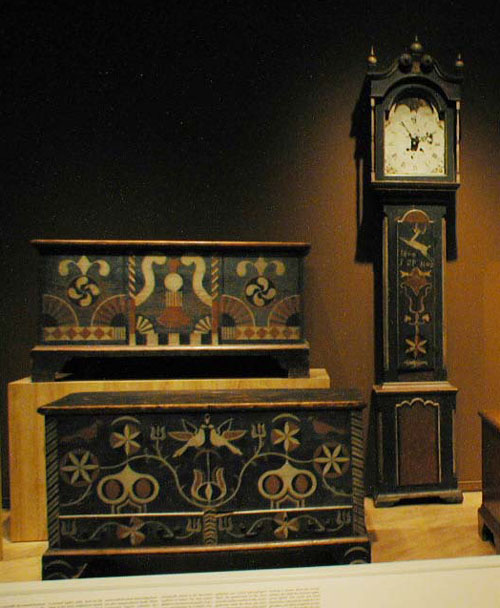

Spitler's colorfully decorated furniture can be divided into three groups distinguished by different painting styles. All reflect the artist's cultural heritage. The first group, which includes the chest in the illustration, features strong geometric designs. Blending colorful squares, circles, diamonds, diagonal bands, and compass-drawn flowers, Spitler created images reminiscent of those used to ornament German- and Swiss-American ceramics, quilts, woven coverlets, and decorated texts, or fraktur.
A second style is seen on the chest below. Differing considerably from the abstract geometric mode, this style emphasizes motifs drawn from nature. Stylized birds, hearts, vines, crescent moons, and compass-drawn flowers that express themes of devotion to family, farming, and God, as well as abundance, divine and romantic love, fecundity, and spiritual growth are featured. This style also includes anthropomorphic figures. On the front panel of the chest are two such characters with inverted, heart-shaped torsos and compass-drawn heads. These composite figures embody the German-American adherence to the Old World belief in the interconnectedness of human beings with the world around them.
The chest above embodies the third style. Also rooted in German-American cultural traditions, this approach is intrinsically linked to the decorative tradition of fraktur, including the illustrated example above the chest. Fraktur alludes to the fractured quality of the pictures and lettering. In a similar vein, the decoration on the front of this chest is visually fractured. The design is a highly stylized, two-dimensional rendering of a real-life object. The inspiration was a tall clock, quite possibly the Spitler-decorated clock seen here.
Painted on the chest are depictions of the clock's broken- scroll pediment and central ball-and-spire finial. The quarter-fans on the chest echo the fanlike rosettes on the clock's pediment, while the black and white frieze at the bottom center of the panel resembles a painted design on another Spitler clock.
The significance of the stylized clock image on the chest is not fully understood. Many ideas remain to be explored, including the German- and Swiss-American fascination with time. More also needs to learned about the case furniture that Spitler painted. Structural variations suggest that at least two or three shops made furniture for Spitler. Nevertheless, these chests and clock represent the hand of a single maker, one whose emphasis on sturdy elements and solid wooden pin construction indicate an awareness of German or Swiss craft traditions.
| Chest |
| Tall Clock |
| Chest |